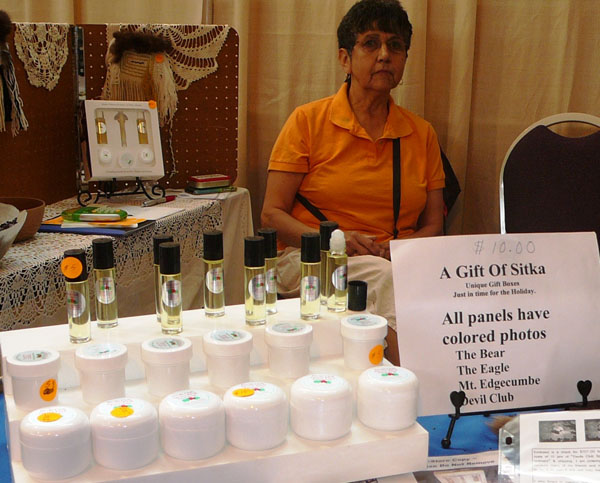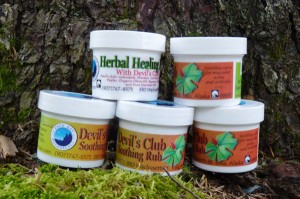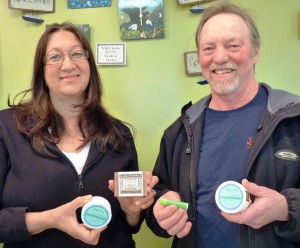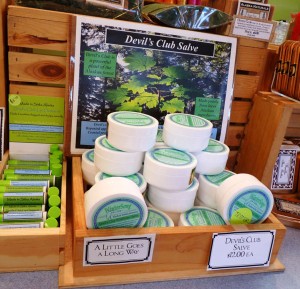
Devil’s club is probably best known as a plant to avoid at all costs. But several small Southeast Alaska companies have a different take. They’re turning the roots, stems and bark of the plant into rubs and salves to treat sore joints and damaged skin. Sitka is the center of the growing industry.
Sitka’s Ruth McMaster stands behind the counter at the store she runs with her husband Gary. The phone rings, and she’s soon taking an order for the company’s devil’s club salves.
Wintersong makes a variety of handcrafted products, including lotions and soaps. But its devil’s club salve and soap are among the most popular – and demand is expanding, “Because it works.”

Devil’s club is a common shrub in the wet, cold forests of Alaska and the Pacific Northwest. Its bright red berries, tall stalks and large leaves make it easy to spot.
But it’s best known for its spiky spines, which cause great pain when they scratch or puncture skin. Jean Longstreth runs Back Bay Botanicals with her husband Dennis.
“Out in the woods, deer-hunting and such, collecting and harvesting other plants, you always saw that ominous-looking plant and you didn’t want to grab onto it,” Longstreth says.
The company, run out of the Longstreth’s home, makes devil’s club salves, balms and bath oil.
Back Bay and Wintersong are among more than a half-dozen Alaska businesses making devil’s club products. Those two, and a third, make Sitka a center of the industry.
“I have the Devil’s Club oil, the lip balm, the ointment and the menthol ointment,” says Pauline Duncan, a Tlingit author and one of the first Native teachers certified in Alaska.

She grew up knowing the plant is a traditional remedy. She followed her interests and built her skills through a class led by a fellow Sitka teacher.
“From there I just started researching and started trying to bring back a lot of the old medicinal plants that were used and mix that in with the devil’s club,” Duncan says.
She and the others collect from their own property, or that of family and friends.
Wintersong’s Gary McMaster says it‘s careful work, because it’s so prickly and stingy.
His advice?: “Wear good gloves, you know, wear good gloves.
Then it has to be processed. Back Bay’s Longstreth says she uses the same technique for devil’s club and other medicinal plants.
“We us an organic olive-oil base, and we simmer the devil’s club at a certain temperature for a number of days until we get as much of the medicine out of it as we can,” she says.
Each follow their own recipe, mixing in spruce pitch, tea tree oil, red clover, beeswax or other ingredients.
The resulting products are used to treat sore joints and muscles, and skin irritations such as diaper rash.
But none of those remedies have been evaluated by the Food and Drug Administration. So Duncan and Sitka’s other manufacturers are careful about what they say.

“I try to get as many of my buyers to give me a little blurb about how it has helped them or why they are ordering more. That’s basically how I advertise the product,” Duncan says.
Those testimonials are used on company websites or in brochures.
Back Bay Botanicals’ Dennis Longstreth enjoys hearing from the customers.
“Every so often there will be a little envelope in the mail, with a tight little handwritten address and we open it up and there’ll be a letter saying somebody gave her this product and it did wonders for her,” he says.
So why is Sitka a center of devil’s club products?
Wintersong’s Ruth McMaster says it’s all about attitudes.
“There’s a lot of independent people here who are seeking out ways to make money besides working for someone else. There’s a lot of entrepreneurs and crafters and artists. I think it goes along with the type of people who live here.”
A few years ago, some Tlingit leaders were concerned large-scale operations could lead to overharvesting of the traditional plant. So far, that doesn’t appear to have happened.
Access websites of some of Alaska devil’s club product producers:
- Back Bay Botanicals, Sitka
- Wintersong, Sitka
- Gut‘ Shu wu Inc., Hoonah
- Alaska Botanicals, Hoonah
- Laughing Berry Botanicals, Metlakatla
- Maiden Alaska Herbs, Skagway
- Birch Grove, Eagle River
- Alaska Ginseng, Anchorage
- Alaska Rod’s, Haines
Ed Schoenfeld is Regional News Director for CoastAlaska, a consortium of public radio stations in Ketchikan, Juneau, Sitka, Petersburg and Wrangell.
He primarily covers Southeast Alaska regional topics, including the state ferry system, transboundary mining, the Tongass National Forest and Native corporations and issues.
He has also worked as a manager, editor and reporter for the Juneau Empire newspaper and Juneau public radio station KTOO. He’s also reported for commercial station KINY in Juneau and public stations KPFA in Berkley, WYSO in Yellow Springs, Ohio, and WUHY in Philadelphia. He’s lived in Alaska since 1979 and is a contributor to Alaska Public Radio Network newscasts, the Northwest (Public Radio) News Network and National Native News. He is a board member of the Alaska Press Club. Originally from Cleveland, Ohio, he lives in Douglas.




